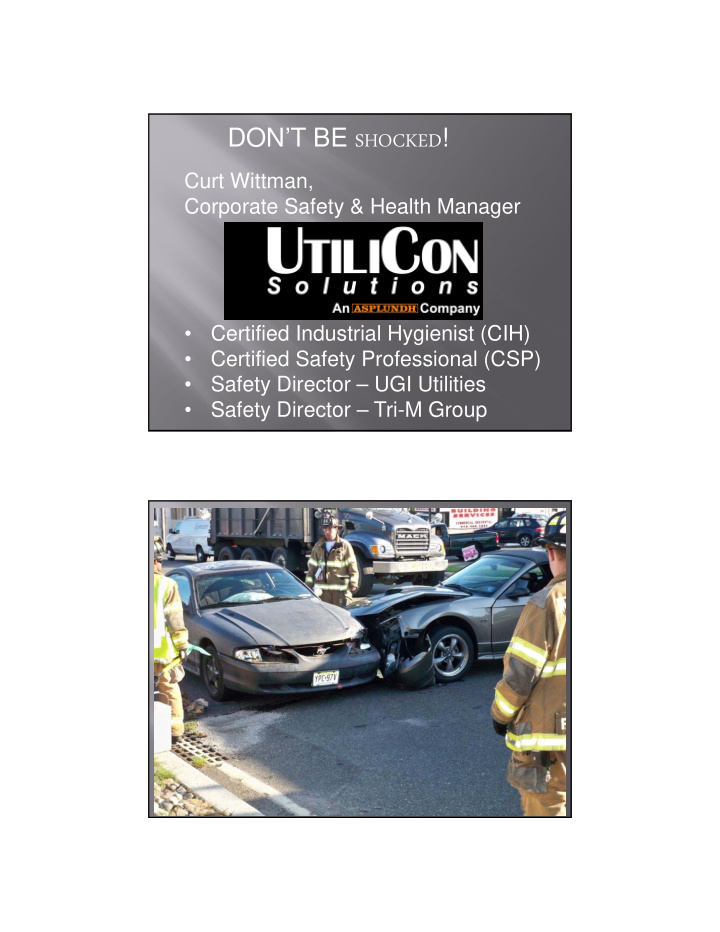



DON’T BE SHOCKED ! Curt Wittman, Corporate Safety & Health Manager • Certified Industrial Hygienist (CIH) • Certified Safety Professional (CSP) • Safety Director – UGI Utilities • Safety Director – Tri-M Group Shocking Statistics • 30,000 electric shocks each year • 600 people die from electrocution each year • Electrocution remains the fourth (4th) highest cause of industrial fatalities
Shocking Statistics Three issues determine if you will be Electrocuted: 1. Type and Magnitude of Electricity (amps/volts) 2. Path through your body 3. Contact time Class NOT designed to teach you to work on electrical equipment You will NOT be QUALIFIED to work on electrical equipment If you spot problems with electrical equipment you should report it to someone
Be familiar with the effects of electricity on the human body Be able to recognize common electrical hazards Be familiar with electrical protective devices • Shock • Electrocution • Fire • Injuries from blasts and falls (Arc Flash)
How many of you have been electrocuted? How many of you have been shocked? More than once? 120 Volts Electrocution • Determined by type of electricity
Electrocution • Determined by the path of electricity Electrocution? • Determined by the amount of contact time
How do you use this? . 120 V 120 V 0 V .
LIMITED APPROACH RESTRICTED APPROACH
LIMITED APPROACH RESTRICTED APPROACH .
.
. .
Inspect all electrical tools and equipment for frayed, cut, broken wires grounding prong missing improperly applied or missing strain relief
#5 1926.403(b)(2) Installation and use. Listed, labeled, or certified equipment shall be installed and used in accordance with instructions included in the listing, labeling, or certification.
#4 1926.416(e)(1) Worn or frayed electric cords or cables shall not be used. #3 1926.405(g)(2)(iv) Strain relief. Flexible cords shall be connected to devices and fittings so that strain relief is provided which will prevent pull from being directly transmitted to joints or terminal screws.
#2 1926.404(b)(1)(i) General. The employer shall use either ground fault circuit interrupters as specified in paragraph (b)(1)(ii) of this section or an assured equipment grounding conductor program as specified in paragraph (b)(1)(iii) of this section to protect employees on construction sites. These requirements are in addition to any other requirements for equipment grounding conductors.
#1 1926.404(f)(6) Grounding path. The path to ground from circuits, equipment, and enclosures shall be permanent and continuous.
DO unplug electrical equipment by grasping the plug and pulling. Do not pull or jerk the cord to unplug the equipment.
DO NOT drape power cords over hot pipes, radiators, sharp objects or through door or window frames DO NOT invent your own electrical equipment equipment
DO NOT use temporary extension cords on a permanent basis. DO steal electricity from your neighbor
DO know the location of electrical circuit breaker panels that control equipment and lighting in their respective areas. Circuits and equipment disconnects must be identified. DO NOT store materials within 3 feet of any electrical panel or electrical equipment
DO NOT lock panel boxes DO NOT be a DARWIN AWARD WINNER
Who is the SAFEST person you know?
Recommend
More recommend